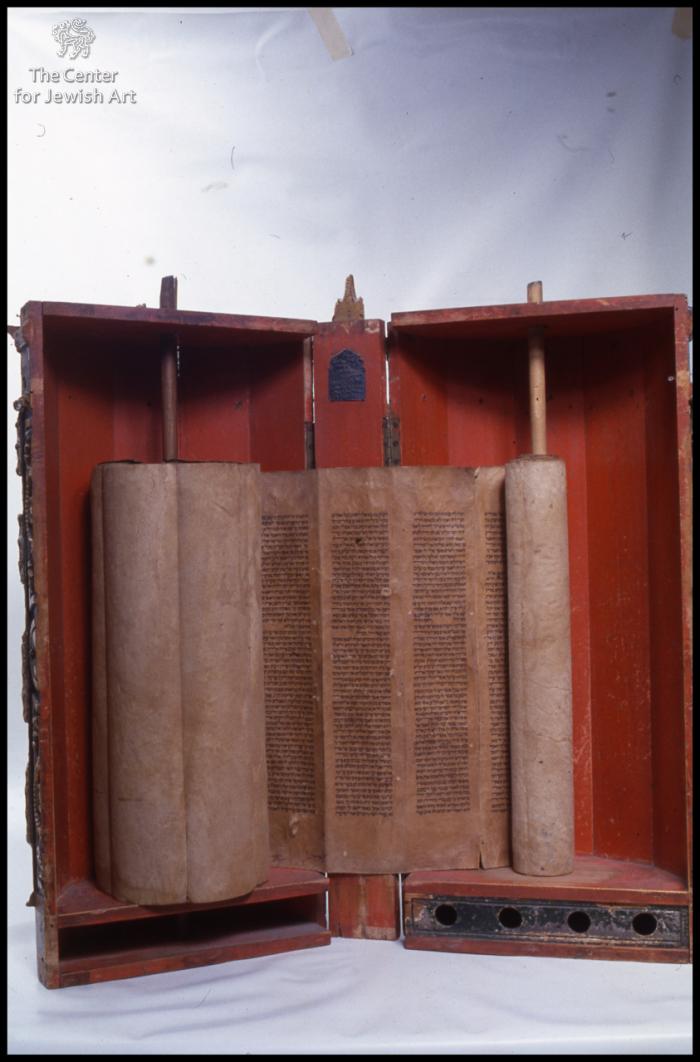Img. ID: 257169

The wooden Torah case consists of a body and a coronet (now missing).
The case opens in the centre on the front facet, forming two halves joined in the back by a steady facet.
The body comprises twelve facets and is encircled, at its upper and lower edges, by two wooden stepped strips creating two friezes, which enclose a dedication. The dedication is inscribed on a parchment attached to the case. It is written in Hebrew square filled letters in two friezes; the lower part is totally illegible, while most of the upper one is readable:
"'וזאת התורה אשר שם [משה] לפני [בני ישראל]' (דברים ד: מד). התיק דמה לאחלמה שבו פטדה (מבוסס על שמות כח:יז-כ). זה הספר התורה הקדוש עשה אתו קודש קדשים ל"ה השם הטוב היקר החשוב הזק(ן(/ [אלי]ה[ו] בכ"ר...."
"'And this is the law which Moses set before the children of Israel' (Deu. 4:44).This case resembles the amethyst, agate, and topaz (based on Ex. 28:17-20; see: Remarks: no. 1). This sacred Torah scroll was sanctified (Holy of Holies) to the Lord, by the one who bears a good name, the precious, honourable and old man Elijah son of….[?]"
Each facet is decorated with a vertical gesso relief composed of a central medallion enclosing an open flower, bordered by two rectangular plates set at top and bottom. The plate is decorated with twin leafy branches forming a lyre shape, and an upright elliptic medallion enfolding a flower between them. The plates and medallions create three circumferential bands. Serrated strips frame the entire body and separate between the facets. The patterns are painted in gold set against a green background.
Only a fragment remains from the coronet. It probably comprised twelve units, which continued the body's facets (see: Remarks no. 2).
The inner face of the Torah case is plain wood and painted red. Each half has a double shelf blocked by a green board at its bottom, and a single one on top.
A silver plaque shaped as a horse-shoe arch is attached to the back facet on its inner side. It is inscribed with a dedication engraved in linear Hebrew letters, and reads:
"זה/ ספר אתורה(!)/ הקדוש הזה/ של השם/ ה'(הטוב) הזקן ה'(החכם) אליהו/ פירצ (פרץ) יצ"ו (ישמרהו צורו ויחיהו) נ' (נדבה) של/ יום ב' כ לחודש/ אדר המאודר(!)/ שנת תקץ לפ' (לפרט קטן)."
"This sacred Torah scroll belongs to of the one who bears a good name, the old and wise man Elijah (Eliyahu) Perez, may the Lord sustain and protect him. A donation (made on) Monday, the 20th of the glorified Adar, the year (5)590, (15.3.1830; see: Remarks: no. 3)."
Two holes for inserting the Torah staves appear at the bottom and top.
1. The names are three out of twelve precious stones set on the Priestly Breast Plate (Hoshen; Ex. 28:17-21). The comparison to the value of the stones of the Hoshen is a recurring clause found in Tunisian dedicatory inscriptions, as the dedication on the case Sc.68-6.
2. From a comparison with a Torah case (Sc.94-12) with similar characteristics and a coronet, we may assume that the missing coronet in our case was similar to the one still adorning the 19th century case (figs. 1,2).
3. To add characteristic features and comparisons for a local work. For a similar case see: Klagsbald, Catalogue Raisonné, 1981, p.93, item 122; Cohen-Grossman, Judaica, 1997, NMNH 217676, p. 144.
-
ה הידיעה – חילופין של ה בא – לבדוק



